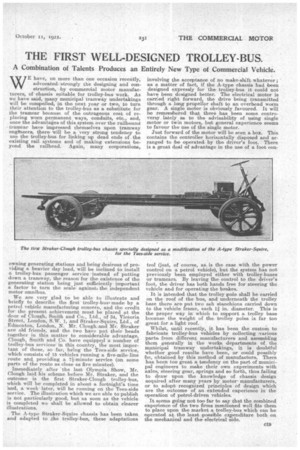THE FIRST WELL-DESIGNED TROLLEY-BUS.
Page 9

If you've noticed an error in this article please click here to report it so we can fix it.
A Combination of Talents Produces an Entirely New Type of Commercial Vehicle.
E have, on more than one occasion recently,•advocated strongly the designing and con struction, by commercial motor manufacturers, of chassis suitable for trolley-bus work. As we have said, many municipal tramway undertakings will be compelled, in the next year or two, to turn their attention to the trolley-bus as a substitute for the tram-car because of the outrageous cost of replacing worn permanent ways, conduits, etc., and, once the advantages of this system over the railbound tramcar have impressed themselves upon tramway ens-JR-leers, there will be a very strong tendency to use the trolley-bus for linking up dead ends of the existing rail systems and of making extensions beyond the railhead. Again, many corporations, owning generating stations and being desirous of providing a heavier day load, will be inclined to install a .trolley-bua passenger service instead of putting down a tramway, the, reason for the existence of the generating station being just sufficiently important a factor to turn the scale • against* the independent motor omnibus.
We are very glad to be able to illustrate and briefly to describe the first trolley-buss made by a petrol vehicle manufacturing concern, and the credit for the present achievement must be placed at the door of Clough, Smith and Co. Ltd., of 34, Victoria Street, London, S.W. 1, and Straker-Squire, Ltd, of Edmonton, London, N. Mr. Cloughsancl Mr. Stra:ker are old friends, and the two have put their heads together in this matter to considerable advantage. Clough, Smith and Co. have equipped a number of trolley-bus services, in this country, the most important of these, so far, being the Tees-side service, which consists of 15 vehicles running a five-mile line route and providing a 7i-minute service, (on some parts of the route as close as five minutes).
Immediately after *the last. Olympia Show, Mr. Clough laid his scheme. before Mr. Straker, and the outcome is the first Straker-Clough trolley-bus, which will be completed, in about a fortnight's. time and, a week later, will be running on the Tees-side service. The illustration which we are able to publish is not particularly good, but as soon as the vehicle is completed we shall be allowed to obtain clearer illustrations.
The A-type Straker-Squire chassis has been taken and adapted to the trolley-bus, these adaptations involving the acceptance of no make-shat whatever;• as a matter of fact, if the A-type chassis had been designed expressly for the trolley-bus it coidd not have been designed better. The electrical motor is carsied right forward, the drive being transmitted through a long propeller shaft to an overhead worm gear. A single motor is obviously favoured. It will be remembered that there has been some controversy lately as to the advisability of using single motor or twin motors but general experience seems to favour the use of die single motor.
Just forward of the motor will be seen a box. This contains the controller horizontally disposed and arranged to be operated, by the driver's foot. There is a great deal of advantage in the use of a foot eon trol (just, of course, as. is the case with the power control on a petrel vehicle), but the system has not previously been employed either with trolley-buses or tramcars. By leaving the control to the driver's foot, the driver has both hands free for steering the vehicle and for operating the brakes,.
It is intended that the trolley poleshall be carried on the roof of the bus, and underneath the trolley base there are put two ash stanchions carried down to the vehicle frame, each It in. diameter. This is the proper way in which to support a trolley base hocause the weight of the trolley poles is far too .great for a light roof.
Whilst, until recently, it has been the custom to fabricate trolley-bus vehicles by collecting various parts, from different manufacturers and assembling them generally in the works departments of the municipal tramway undertakings, it is doubtful whether good results have been, or could possibly be, obtained by this method of manufacture. There has. been too great a tendency on the part of municipal engineers to make their own experiments with axles steering gear' springs and so forth, thus failing to draw upon the knowledge of chassis design acquired after many years by motor manufacturers, or to adopt recognized principles of design which are the outcome of an •extended experience in the operation of petrol-driven vehicles.
It seems gef.ng not too far to say that the combined experience of the two firms mentioned well fits them to place upon the market a trolley-bus which can be operated at the least possible expenditure both on the mechanical and the electrical side.




















































